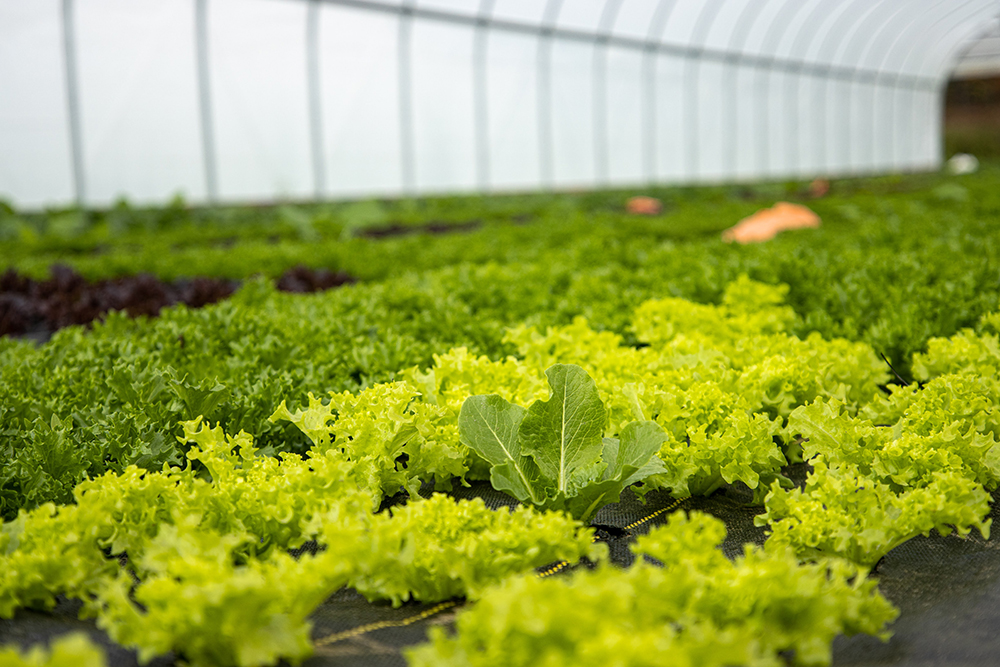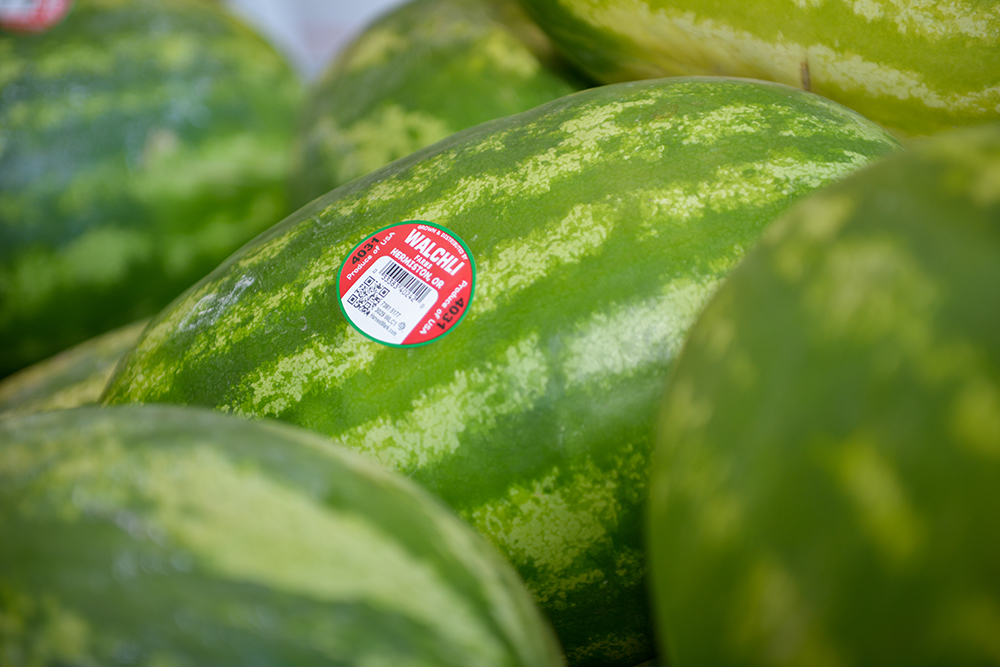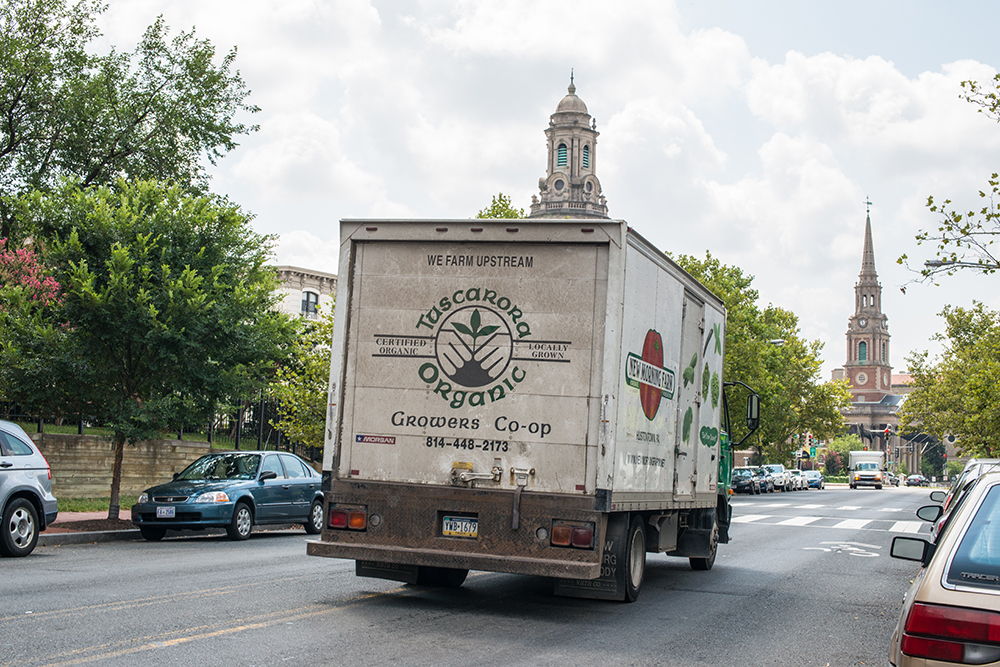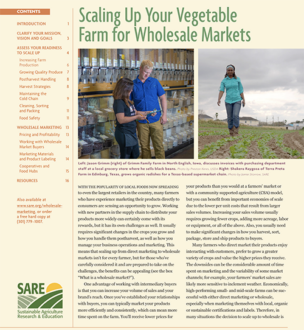
Determining which markets and marketing strategies will work best for you is something you should thoroughly explore before investing in farm expansion. While buyers in the wholesale market share general characteristics as far as their emphasis on higher volumes and greater consistency of product quality and delivery compared to direct market channels, individually they’re unique in some ways that could affect which one or ones make the most sense for you.
Some of the ways wholesale markets can vary include:
- The volume you can sell, the price you receive and when payment is made to you
- How you create and manage relationships, use contracts and negotiate prices with buyers
- Delivery logistics, such as how far you may need to drive, when and how often
- The need for liability insurance, a food safety plan and other documentation
- Whether your brand adds value to the exchange
Resources to help you evaluate the pros and cons of common wholesale markets in more depth include:
- ATTRA’s Marketing Tip Sheet Series
- Rutgers University’s To Market, To Market: A Workbook for Selecting Market Options and Strategies for Agricultural Products
- SAREP’s market channel tip sheets and other resources at their How to Sell Produce Wholesale website.
Pricing and Profitability
In wholesale markets, prices will not be near direct market prices or the retail prices consumers end up paying. In many cases, you’ll be competing with regional, national and international producers. Some buyers will recognize and value that your farm is local or certified organic, and you can earn higher prices in these “values-based supply chains.” Other buyers will be seeking the cheapest supplier available. Ultimately you make up for the lower pricing through higher volumes.
Keys to ensuring profitability include:
- Maintaining consistent production volumes and sales
- Knowing your production costs
- Researching market prices and contacting buyers to learn about both their pricing policies and their desired volumes
- Accounting for seasonal and annual price volatility
- Developing a diversity of wholesale channels
The USDA Agricultural Marketing Service publishes daily price reports at terminal markets around the country as well as historical data by commodity group, which can give you some idea of national wholesale prices. However, terminal prices are generally significantly lower than what a grocery store or restaurant would pay to a distributor, and many small and mid-sized farms selling into local markets expect to receive a premium above nationally shipped product.

For starters, it’s critical to understand your cost of production and how much you need to charge for a crop to be profitable. A healthy working relationship with a buyer can be the best way to establish prices that are fair for both parties and reasonable enough for the end consumer so that your product keeps moving with strong sales. Another strategy is to have a distributor that markets products with similar qualities as yours into your end market (perhaps local or organic) add you to their product availability price list email so you can watch prices in real time as they’re affected by weather and seasonal impacts.
As with direct marketing, it’s essential to take the time to calculate your return on investment for both your current production and marketing situation, and for your anticipated situation. You’ll want to include costs associated with production, harvest, postharvest, packaging and delivery, as well as costs for land, facilities and equipment associated with producing the crop in question. Use your research on wholesale market prices to complete the picture. Enterprise budgeting tools and resources are readily available through state Extension offices.
Working with Wholesale Market Buyers
It’s important to build a relationship with wholesale market buyers that involves clear communication from both parties so that all can be successful. Take time to learn about the products and volumes each buyer wants, and when throughout the year they want them. Also learn about their requirements and preferences as far as pricing, billing and invoicing, packaging, labeling, food safety standards, delivery procedures, mode and timing of communication, and points of contact. North Carolina State Extension’s guide How to Sell Produce to Distributors includes a list of questions to ask distributors to glean important information, as well as questions you might expect to receive from them.
When starting out, contact potential buyers when they’re less busy, such as the off season. Be ready to share as much helpful information about your operation as you can, such as branding materials, food safety documentation, recent yield data, and an upcoming planting and harvest schedule. It also helps to provide samples of packaged products to demonstrate that you know how to grow, handle and package a quality product.
Be aware of the ongoing communication that will be needed after you’ve found a willing buyer. For example, be ready to provide buyers with up-to-date product availability and price lists, and communicate with them 1–2 weeks in advance of an individual crop’s harvest to let them know it’ll be available soon. Also, with each order that’s placed there should be consistent communication, which may include a confirmation that you received an order, a pending invoice, a packing slip included with the delivery and a final invoice. Agree on protocols for these kinds of communication at the beginning of the relationship, and keep records of all of them. Finally, respond quickly and professionally if questions should arise, or if you need to make any changes to your arrangement.
Many fee-based online tools exist to help you manage product lists, ordering, invoicing and other important communications with your buyers, for example Local Food Marketplace and FarmersWeb. (These commercial services are being provided as examples only, and mention or exclusion of a product does not imply a positive or negative endorsement by SARE.)
Marketing Materials and Product Labeling
An effective way to maximize your market presence may be to “co-market” your product through your buyer. Shelf talkers, branded price signs and social media are examples of how you can differentiate your product from competitors and “tell your story” to a broader audience than you may reach through direct marketing. These efforts can create brand loyalty with consumers and can help your buyers stay competitive in a challenging grocery market. If this is important to you, seek out buyers who want to retain your farm’s identity and values through the distribution chain to the grocery store shelf or restaurant table. Many state departments of agriculture have strong marketing support programs that you should integrate where useful into your marketing plan. Many commercial buyers value these branding programs.
A good farm website that gives consumers information about your farm, how to find you and how to order products is highly effective when you’re direct marketing. In the wholesale context, your website can show buyers your professionalism as a businessperson, so it should be well organized, well designed and mobile friendly. Many free and low-cost tools exist to build a website yourself.
At a minimum, you should include your farm logo and values through packaging to differentiate your farm from the competition. Along with being certified organic (if applicable), explore third-party verification and labeling around different types of standards. You may not need such certifications when you’re direct marketing because you can share your values in other ways, but as you enter a longer supply chain, labels can communicate that you’re local or that you use sustainable farming practices. There are many third-party certifications out there and each comes with its own cost, audit process and level of recognition among consumers, so be discerning in which one(s) you pursue.
The labeling that’s required will vary depending on the buyer and the product. For example, loose apples, a bag of potatoes and a jar of almond butter all have different requirements. Labeling requirements can range from simple stickers on produce to the weight of a package, a list of ingredients, nutritional content, a bar code and other information. If you’re unsure of what’s required, talk to your buyer and seek further guidance from your state Extension office or state department of food and agriculture. While it could be burdensome to navigate initially, packaging presents another opportunity to think through how you want to brand your farm and its products for the end consumer.
When selling loose produce in wholesale markets, your buyer may require stickers that include the price look up (PLU) code. Even when not required, including these labels can give you an advantage over competitors who don’t use them. PLU stickers appear on individual pieces of produce and include standardized 4- and 5-digit codes that help cashiers quickly look up the retail price at checkout. Work with your buyer or visit www.plucodes.com to ensure you’re using the correct number for a particular product; for example, tomatoes can have several different PLU codes depending on how they were grown, their size, variety, etc. You can either customize your own labels or order predesigned ones from a label and packaging supply company. Designing your own provides yet another opportunity to add your logo to your product for the consumer to see, but if you do so, follow best practices as far as label dimensions and font size.
Cooperatives and Food Hubs
If the requirements of scaling up to wholesale markets are too great, look for opportunities to work with nearby aggregators such as cooperatives and food hubs. These entities will pool the crops grown by many farmers in order to achieve the scale that buyers want, and they will usually provide those services that small-scale farmers find the most daunting, such as refrigerated trucking and storage, marketing, sales and recordkeeping. Food hubs often include staff who can help farmers improve their crop production practices to meet wholesale market standards. Although, be prepared to still meet certain requirements of wholesale marketing, such as creating a food safety plan and removing field heat from crops at harvest.
Formal co-ops are member-owned business entities, and if you join one, expect to pay an annual membership fee that supports the staff, infrastructure and services the co-op is providing. In addition, you may be required to participate in its governance in some way. Because the co-op exists to serve its members, your participation is a form of oversight to make sure the co-op is performing to the mutual benefit of its members. Important questions to ask yourself before joining a co-op include:
- Does the co-op have a good, long-term track record of success?
- In exchange for not having to handle many of the day-to-day tasks of marketing myself, am I willing to instead work with other farmers to provide governance of the co-op?
- Am I willing to adhere to standards that are collectively established by the members?
The Fresh Farm HQ Cooperative Association, a Kansas City area co-op of small- and mid-scale farms created to better access local wholesale markets, found itself struggling in a crowded field. So, in 2017, the co-op used a SARE grant to reevaluate its branding strategies and to improve the food safety and traceability compliance of its members. One outcome of the project was to create professional marketing materials and rebrand the co-op with the name Kansas City Food Hub, steps that have helped the co-op grow from 10 members in 2017 to 22 in 2021.

“The new name and professional material that was developed out of this effort raised the profile of the organization,” said Katie Nixon, a farmer member who serves on the co-op’s board of directors.
In recent years, some Kansas City Food Hub members have received additional SARE grants to build the co-op’s capacity to supply allergy-friendly prepared foods to area school systems, a niche they’ve identified as having a lot of unmet demand.
There are ways to collaborate with fellow farmers to meet the requirements of wholesale markets other than joining or creating a co-op. However, any partnership carries with it important legal and risk management considerations that you and potential partners should explore thoroughly, in consultation with accountants and lawyers. Eventually, you’ll want to create a formal agreement and establish an appropriate business structure, such as a limited liability corporation, to shield you from risk should the partnership run into unexpected trouble. Farm Commons has extensive free videos and print materials to download about the business structure options available to you, including, Farm Business Structure Basics and What, Why, and How of Choosing a Business Entity for the Farm. Chapter 12 of the book Farmers’ Guide to Business Structures, published by Farm Commons and SARE, reviews the issues farmers should consider when entering into partnerships.
Resources
The following is a list of in-depth guides on the topic of preparing your vegetable farm for wholesale markets. This list is not intended to be comprehensive. Consult with your local Extension office for resources that are tailored to your geographic area and type of operation.
How to Sell Produce Wholesale
The University of California’s Sustainable Agriculture Research & Education Program’s (SAREP) online resources at How to Sell Produce Wholesale include information on market channels, working with buyers, food safety, packing and grading, pricing and other important business aspects of wholesale marketing. https://sarep.ucdavis.edu/fs/supply/wholesale
The MarketReady Producers Program
This training program offered by the University of Kentucky includes both virtual sessions and online guides that provide best practices and information about commercial buyers’ expectations across 12 core business functions, such as communication and relationship building, packing and labeling, and pricing strategies. https://marketready.uky.edu/
NCAT ATTRA
The National Center for Appropriate Technology’s ATTRA program offers dozens of publications on marketing-related topics, including Scaling Up Your Vegetable Farm for Regional Markets and the Marketing Tip Sheet Series, which summarizes the pros and cons of the most common direct-market and wholesale channels. attra.ncat.org/topics/marketing-business
Small-Scale Postharvest Handling Practices: A Manual for Horticultural Crops
This comprehensive guide on postharvest handling practices is published by the University of California Davis. It covers a variety of topics like harvesting, packaging and packinghouse, transportation and processing strategies. https://postharvest.ucdavis.edu/publications
To Market, To Market
Published by Rutgers University, To Market, To Market: A Workbook for Selecting Market Options and Strategies for Agricultural Products is a decision tool that helps beginning and established farmers consider which direct and wholesale markets might work best for them. https://sites.rutgers.edu/farm-management/wp-content/uploads/sites/752/2022/09/tomarket.pdf
